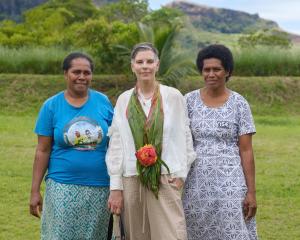Amber Bridgman’s heritage is intertwined into every aspect of her life including her label Kahuwai. She tells Amy Parsons-King about her Australian fashion show debut.
A Dunedin designer's sense of ''nostalgia with rich combinations of culture, couture and vintage elegance'' has won her accolades in the Australian fashion world.
Amber Bridgman's Kahuwai clothing range started out as a children's label but soon morphed into women's and menswear with a strong indigenous flavour.
That flavour comes from Bridgman's heritage as a descendent of Kai Tahu, Kati Mamoe, Waitaha, and Rabuvai-Rakiura Maori from Stewart Island.
She is extremely proud of her heritage, naming her label Kahuwai, an amalgamation of two Maori words - ''kahu'' meaning a guardian bird and ''wai'' representing water and spiritual wellbeing.
Bridgman was born and raised in Dunedin with her older sister and although her mother is Maori, Te Reo was not spoken in the home and Maori culture wasn't strongly acknowledged.
It wasn't until she reached high school that Bridgman began taking an interest in her whakapa and so began her life-long journey to connect with her genealogy.
She began learning the language and teaching herself the traditional art of Maori weaving.
The desire to weave was sparked by her aunty showing her a kete (woven flax basket) which was created by her great-great-grandmother, Granny Dawson, of Stewart Island.
''Seeing that kete sparked a spiritual call to the island and to continue my understanding of the traditional Maori crafts of my southern Maori history.''
Although Bridgman continued to weave and pursue various arts throughout high school, on finishing she decided to study broadcasting.
''When I left school a career liaison at the university, Alva Kapa wanted to know what I was planning on doing with my life. I replied, 'I want to become a pro-surfer and travel around NZ in a Kombi van', but between Alva and my mother that wasn't happening.''
Instead they strongly encouraged her to enrol at the Otago Institute of Television, Radio and Theatre School, where she specialised in television production.
Graduating from the television school enabled Bridgman to enjoy a career in broadcasting, working in various roles, including production, set-design, directing and as a presenter for Auckland-based show Mai Time and as a breakfast radio host on Tahu FM.
She continues to work in broadcasting.
It was while presenting on Mai Time that Bridgman became pregnant with twins, and returned to Dunedin to raise her family and buy a home.
Having the twins was the catalyst for her launching Kahuwai, which originally started out as a children's label.
''I couldn't find any clothes I liked on the market for the boys so I started making their clothes and screen-printing them with Maori art and sayings.
''There also wasn't any television work going in Dunedin either so I decided to focus on another interest of mine, fashion design.
''I gradually started making men's and women's wear too, which I received lots of positive feedback about. Diane Waugh of Waughs was really supportive and one of my first stockists.''
Over the years Bridgman has enjoyed a lot of success with her label, at one time stocking 18 stores around the country.
She has also been involved in iD Dunedin Fashion Week, shown at New Zealand Fashion Week, Style Pasifika and the Hokonui Fashion Awards, among other outings, and last month made her Melbourne Fashion Festival debut, showing in the Global Indigenous Runway show.
At the festival Bridgman showcased 10 outfits, each telling a story and inspired by personal life events, including the sudden death of her father 20 months ago.
Her opening ensemble depicted Hine-nui-te-po, the goddess of death and consisted of a woollen cape with hand-printed designs, heavily beaded corset, voluminous pleated skirt, accessorised with an over-sized pounamu necklace.
Other ensembles carried political messages, such as the Maori struggle with land confiscation, Maori language revitalisation and mutton-birding.
A fear-invoking red military jacket worn by Pakeha soldiers during land-seizures also made an appearance, as did cascading ruffles, pleats, vintage lace, rare feathers, pewter jewellery, beading and harakeke piupiu skirts worn as capes. All of which were hand-made using traditional techniques.
The collection received a lot of positive feedback, the show's organiser, Tina Waru, founder and chief executive of Global Indigenous Management, saying Bridgman was at the top of her game.
''It was an absolute pleasure to have Amber participate as one of New Zealand's top designers.''
Having the Global Indigenous Runway as part of the fashion festival's core official programme provided the opportunity to showcase the very best indigenous designers from around the world.
''Amber is certainly top of her game. Amber's collection brought back a sense of nostalgia with rich combinations of culture, couture and vintage elegance.
''It is time we celebrated the success of all our indigenous designers on one of the world's top international fashion platforms.''
Since showing at Melbourne Fashion Festival, Amber has made plans to return to Australia for a spring fashion festival and to hold a local show during Matariki. She will also be putting some of the garments from the collection into production.
















